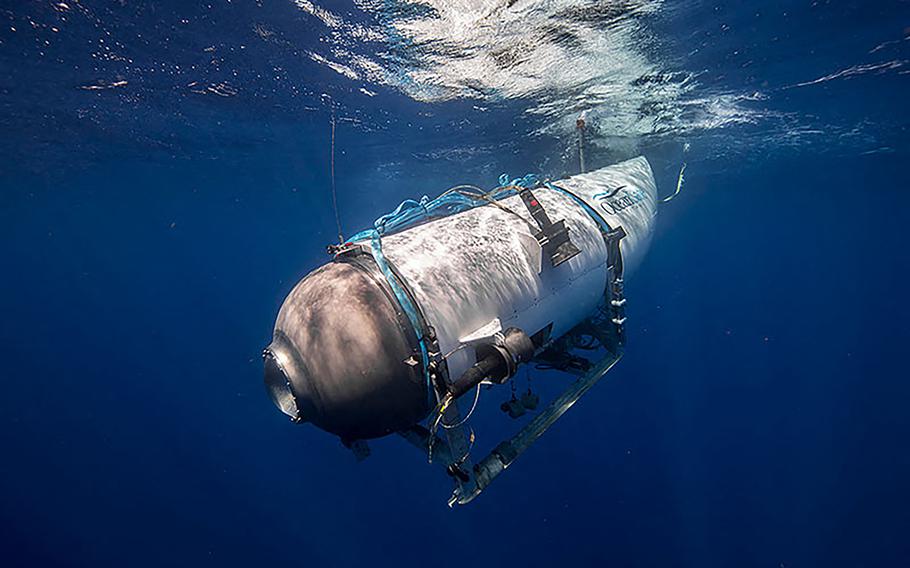
Undated handout image of Submersible Titan. On June 18, 2023, the submersible vanished on expedition to the Titanic wreckage. It suffered a catastrophic implosion, killing all onboard. (OceanGateZuma Press Wire via TNS)
The implosion of the Titan submersible and the death of all five aboard was “preventable” if not for the sub owner’s “failure to follow established engineering protocols,” the U.S. Coast Guard said Tuesday.
The Titan was on a trip to visit the wreckage of the Titanic when it imploded on June 18, 2023. The disaster brought international attention to deep-sea tourism, which experts say lacks adequate oversight to ensure safety. The Coast Guard’s 335-page report follows a two-week investigative hearing in September.
The report blamed the company behind the submersible, OceanGate, for using “intimidation tactics” and “strategically creating and exploiting regulatory confusion and oversight challenges.”
It also criticized OceanGate co-founder and CEO Stockton Rush’s lack of third-party oversight, writing that he did “completely ignore vital inspections, data analyses, and preventative maintenance procedures, culminating in a catastrophic event.”
Rush died in the Titan’s implosion. Had he lived, according to the report, the Coast Guard investigation board members would have recommended the Justice Department consider filing federal criminal charges based on his negligence as CEO and pilot during the incident.
OceanGate had been informed of risks with the Titan’s design, including the possibility of the sub’s glue joints failing and the experimental choice to use carbon fiber, an unproven material in deep-sea conditions, the Coast Guard report said. But the company failed to adequately test the Titan to account for those risks.
Investigation of debris from the Titan showed the adhesive gluing the craft’s carbon fiber hull to titanium segments at the front and back of the sub failed, according to the report.
The implosion likely destroyed the craft in an instant. The Titan’s viewport was never found, suggesting it had been blown outwards in the implosion and buried in the seafloor, the report said.
The Coast Guard report includes several recommendations, from technical to sweeping. They include updating the 30-year-old regulations governing submersibles used for research and business purposes, including the creation of a clear process for certifying new submersible designs.
During the September hearing, witnesses told the Coast Guard that OceanGate’s expeditions were marked by equipment problems and disagreements over the development of the Titan sub.
The CEO of a submersible manufacturing company deemed a prototype of the Titan “amateurish” after inspecting it in 2019, he testified, and an engineering contractor who worked with OceanGate said the company had a culture of “safety theater” and often dismissed concerns from experts.
OceanGate’s own director of marine operations frequently raised safety concerns to other company leaders about the Titan sub but was fired by Rush in 2018, the Coast Guard report said.
After being fired, the former director filed a retaliation complaint with the Occupational Safety and Health Administration. OceanGate then sued him for sharing confidential information with OSHA.
An OSHA investigator assigned to the case said he faced a backlog of complaints at the time, and OSHA never began an investigation into OceanGate, according to the Coast Guard report. The former director withdrew his complaint in December 2018, citing the emotional toll of the legal battle with OceanGate.
Other sub operators and former OceanGate employees also testified that the company tried to skirt federal regulations by designating Titan passengers as “mission specialists.” In reality, the “mission specialists” performed no specialized work and in fact paid to be on the sub.
OceanGate co-founder Guillermo Söhnlein, who left the company in 2013, told the Coast Guard that the company employed the tactic to save money.
Since the Titan imploded, the Coast Guard has “significantly increased its professional interactions with the submersible industry,” according to the report. The Coast Guard now participates in industry conferences and engage with industry leaders to “promote improved safety standards.”
Searchers found what was left of the Titan submersible June 22, 2023. The implosion of the Titan killed Rush along with his four other passengers: British aviation businessman Hamish Harding, 58; retired French navy commander Paul-Henri Nargeolet, 77; British Pakistani businessman Shahzada Dawood, 48; and his 19-year-old son, Suleman.